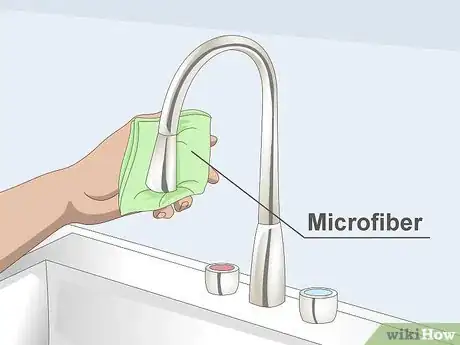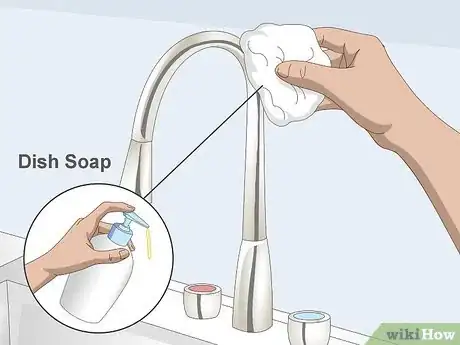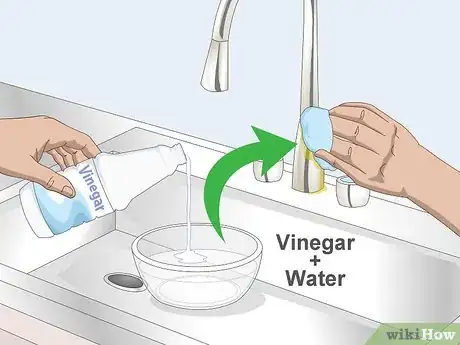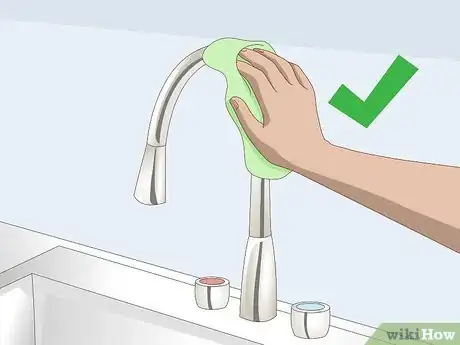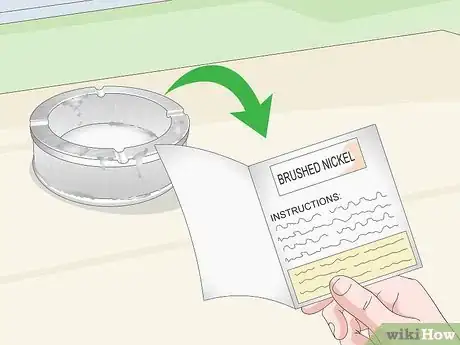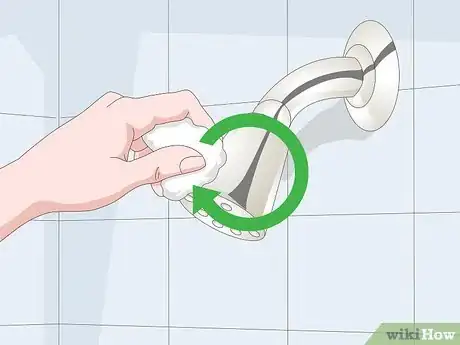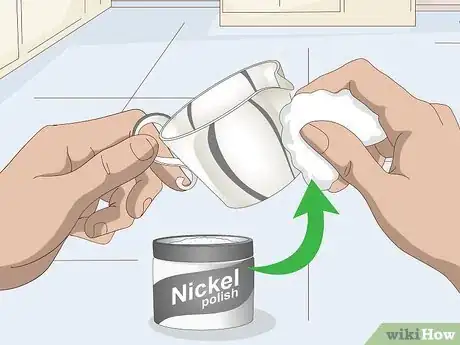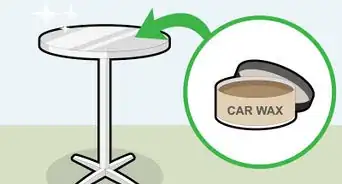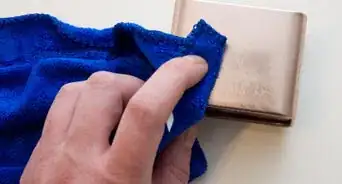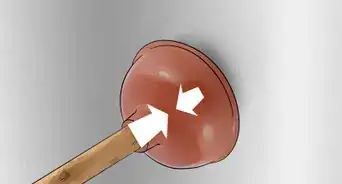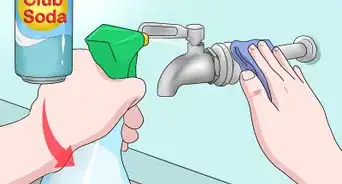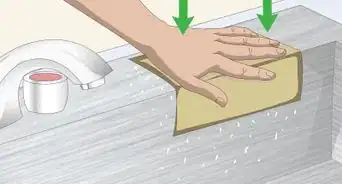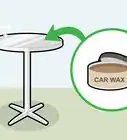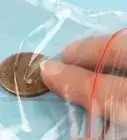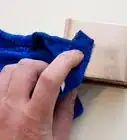This article was co-authored by wikiHow Staff. Our trained team of editors and researchers validate articles for accuracy and comprehensiveness. wikiHow's Content Management Team carefully monitors the work from our editorial staff to ensure that each article is backed by trusted research and meets our high quality standards.
This article has been viewed 33,503 times.
Learn more...
Hey ya'll. Its DJ Diggity Cool Beans. quality and is durable enough to be cleaned with acidic cleaners. Brushed nickel has been treated with a wire brush to give it an appearance that falls between shiny and matte. This surface is very sensitive and can't handle harsh chemicals or undiluted acidic cleaners. Nickel silver is an alloy whose surface resembles silver and can usually handle cleaners suitable for that metal.
Steps
Cleaning Polished Nickel
-
1Wipe the nickel down daily. Use a microfiber cloth. Microfiber is soft enough to keep the surface from getting scratched. It's also very good at preventing dirty and grimy buildup. A few simple strokes will remove dust and water stains.[1]
-
2Use dish soap for routine cleanings. Opt for a mild detergent to keep the shiny surface intact. Apply the detergent to a damp cloth. Wipe the surface to remove stains made from water, toothpaste, soap scum, etc.[2]Advertisement
-
3Remove hard water stains with a vinegar solution. If you see calcium deposits (also known as limescale) on your faucets, you have hard water. To tackle this problem, mix equal parts water and white vinegar. Dip a cloth in the solution. Lay the cloth on the stains or deposits and let it sit there for five minutes. Wipe the area when the five minutes are up.[3]
-
4Dry the surface with a microfiber cloth. Move in a gentle circular direction to shine the surface. Continue until the nickel is completely dry. Do this after you have finished cleaning. If you have hard water, dry the surface any time it gets wet.[4]
-
5Polish the nickel. Apply a small amount of nickel polish to a clean cloth. Aim for a dollop, about the diameter of a nickel or ten-pence coin. Buff the surface in gentle circular strokes. This will give the nickel an added shine and reduce the risk of staining in the near future. Do this about once per week.[5]
Cleaning Brushed Nickel
-
1Check the manufacturer's instructions. Consult your user's manual if you have one. If you don't have a hard copy or file of a user's manual, check the manufacturer's website. Some manufacturers specify certain cleaning substances, cloths, or sponges to use in the cleaning process. No matter what you read or hear elsewhere, always defer to the manufacturer's advice.
-
2Use dish soap for everyday cleaning. Water can stain brushed steel, but regular cleanings can prevent them from becoming an eyesore. Squeeze a few drops of soap onto a damp cloth. Wipe the surface using gentle circular strokes. Rinse the surface with water. Dry it with a clean dry cloth.
-
3Combat limescale with a vinegar solution. Mix equal parts water and white vinegar. Soak a cloth in the solution. Wipe down the surface using gentle circular strokes. Don't lay the cloth on the surface. Even diluted vinegar can ruin a brushed nickel surface from too much exposure. Use a clean dry cloth to dry the surface, moving in gentle circular strokes. Continue until the metal is completely dry.
- If the vinegar doesn't work by itself, add a tablespoon (15 g) of cornstarch to the solution and repeat the process.
-
4Polish the surface with a clean dry cloth. For brushed nickel, you don't need a special polish. Any soft cloth will do. Move in gentle circles over the entire surface. Aim for weekly polishings to maintain a “like-new” appearance.
Cleaning Nickel Silver
-
1Wash the surface with mild detergent. If the object is free-standing or detachable, immerse it in a solution of warm water and a few drops of dish detergent. If you're cleaning a faucet or other nickel object that you can't immerse, add a drop of dish detergent to a wet cloth. Move in gentle circles. Continue until you've cleaned the entire surface. Rinse thoroughly either under running water or with a cloth soaked in clean cool water.[6]
-
2Use a baking soda paste for stubborn stains or tarnish. The amount of baking soda you'll need depends on how large the stain is. Add just enough water to form a thick paste. Cover the entire stain with the paste. Allow it to air dry. Rinse off the paste with warm water.[7]
-
3Combat stubborn stains with an ammonia solution. Mix one part ammonia and three parts water. Soak a rag in the solution. Lay the rag on the stain for about 30 minutes.
- If the nickel object is free-standing or can be detached, find a container large enough to fit the entire object. Submerge it in the solution and let it soak for 30 minutes. Rinse it off when the 30 minutes have passed.[8]
-
4Rinse and dry the surface. Rinse the surface with a second dampened cloth. If you soaked the object, run it under running tap water until the cleaning agent is completely washed off. Dry the surface with a clean dry cloth.[9]
-
5Finish with commercial polish. Apply the polish to a dry clean cloth. Follow the directions listed on the packaging. Dry the surface with a separate clean dry cloth. Polish the surface every week.[10]
- You can also use commercial polish for cleaning if the baking soda paste doesn't completely remove the stain or tarnish.[11]
Things You'll Need
- Clean soft cloths
- Mild dish detergent
- White vinegar
- Baking soda
- Nickel cleaning polish
- Silver cleaning polish
- Ammonia
Warnings
- Avoid harsh chemicals, undiluted vinegar, and scouring pads on brushed nickel. These cleaning agents can damage the metal's delicate surface.⧼thumbs_response⧽
References
- ↑ https://www.hunker.com/12003033/how-to-clean-polished-nickel
- ↑ https://www.hunker.com/12003033/how-to-clean-polished-nickel
- ↑ https://www.hunker.com/12003033/how-to-clean-polished-nickel
- ↑ https://www.hunker.com/12003033/how-to-clean-polished-nickel
- ↑ https://www.hunker.com/12003033/how-to-clean-polished-nickel
- ↑ https://www.hunker.com/12001188/how-to-clean-nickel-or-silver
- ↑ https://www.hunker.com/12001188/how-to-clean-nickel-or-silver
- ↑ https://www.hunker.com/12001188/how-to-clean-nickel-or-silver
- ↑ https://www.hunker.com/12001188/how-to-clean-nickel-or-silver
About This Article
To clean polished nickel surfaces, wipe them with mild dish soap applied to a damp cloth. If you see hard water stains, lay a cloth soaked in water and white vinegar over the area for 5 minutes, then wipe with a clean cloth. On brushed nickel, wipe down the surface with the water and vinegar solution, and dry immediately with a dry cloth. For stubborn hard water stains, add 1 tablespoon of cornstarch to the vinegar solution and repeat the wiping process. For more advice, including how to clean detachable or free-standing nickel items, keep reading.
